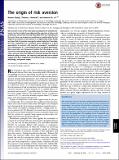The origin of risk aversion
Author(s)
Zhang, Ruixun; Brennan, Thomas J.; Lo, Andrew W.
DownloadZhang-2014-The origin of risk a.pdf (614.5Kb)
PUBLISHER_POLICY
Publisher Policy
Article is made available in accordance with the publisher's policy and may be subject to US copyright law. Please refer to the publisher's site for terms of use.
Terms of use
Metadata
Show full item recordAbstract
Risk aversion is one of the most basic assumptions of economic behavior, but few studies have addressed the question of where risk preferences come from and why they differ from one individual to the next. Here, we propose an evolutionary explanation for the origin of risk aversion. In the context of a simple binary-choice model, we show that risk aversion emerges by natural selection if reproductive risk is systematic (i.e., correlated across individuals in a given generation). In contrast, risk neutrality emerges if reproductive risk is idiosyncratic (i.e., uncorrelated across each given generation). More generally, our framework implies that the degree of risk aversion is determined by the stochastic nature of reproductive rates, and we show that different statistical properties lead to different utility functions. The simplicity and generality of our model suggest that these implications are primitive and cut across species, physiology, and genetic origins.
Date issued
2014-12Department
Massachusetts Institute of Technology. Computer Science and Artificial Intelligence Laboratory; Massachusetts Institute of Technology. Department of Mathematics; Sloan School of ManagementJournal
Proceedings of the National Academy of Sciences
Publisher
National Academy of Sciences (U.S.)
Citation
Zhang, Ruixun, Thomas J. Brennan, and Andrew W. Lo. “The Origin of Risk Aversion.” Proceedings of the National Academy of Sciences 111, no. 50 (December 1, 2014): 17777–17782.
Version: Final published version
ISSN
0027-8424
1091-6490